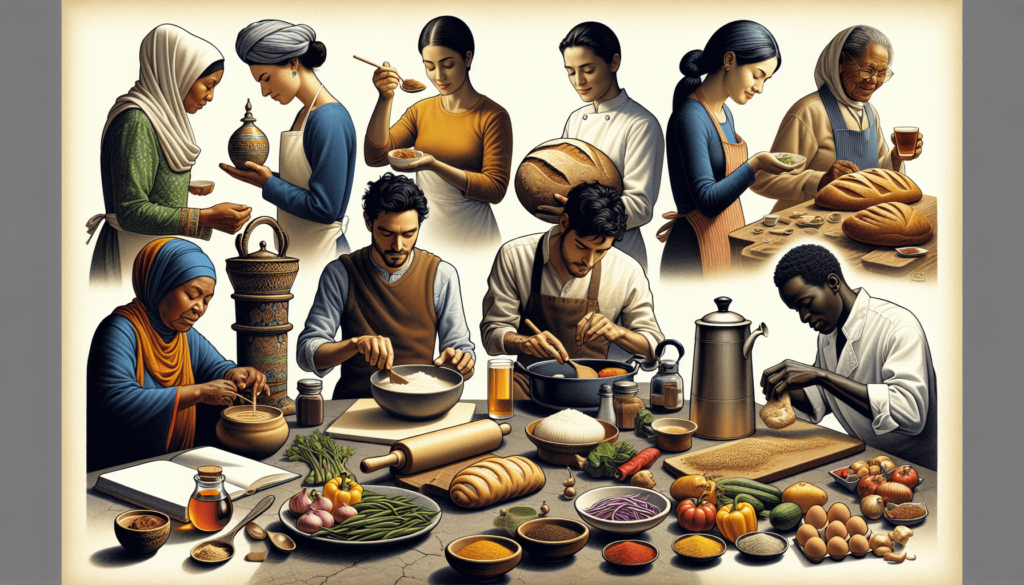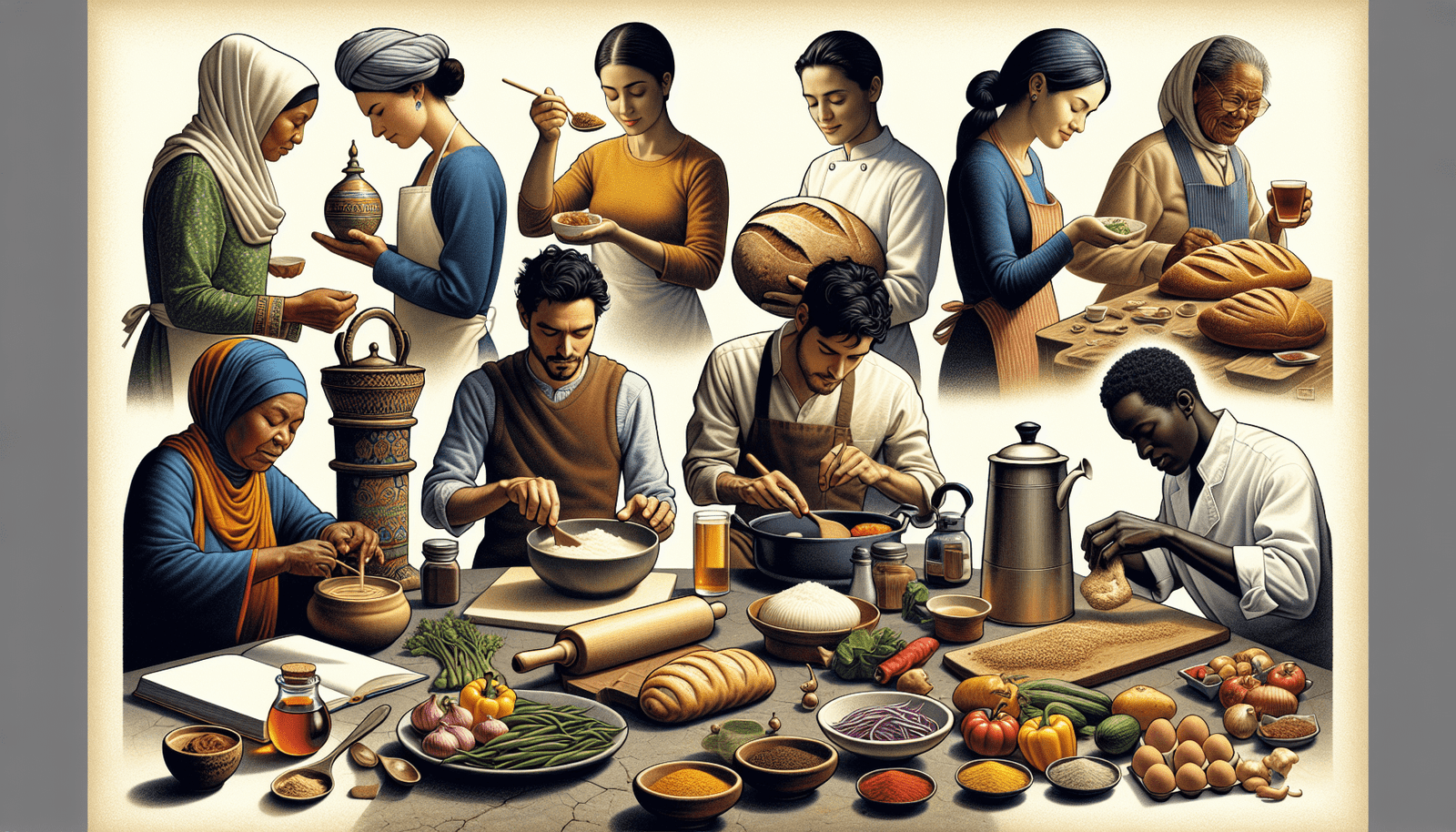In this article, you will embark on a fascinating journey into the diverse world of ethnic diets. From the vibrant flavors of Mediterranean cuisine to the nourishing traditions of Asian cooking, we will explore the rich tapestry of global culinary practices that have been cherished for generations. Discover the secrets behind these time-honored diets and their potential impact on our overall health and well-being. Get ready to tantalize your taste buds and expand your culinary horizons as we delve into the fascinating realm of ethnic diets and their global traditions of health.

Understanding Ethnic Diets
What are ethnic diets?
Ethnic diets refer to the specific eating patterns and culinary traditions followed by different cultural and regional groups around the world. These diets are influenced by the availability of local ingredients, cultural practices, and historical influences. They play a crucial role in defining the food heritage of different communities and significantly contribute to their overall health and well-being.
Importance of ethnic diets in global traditions of health
Ethnic diets have been passed down through generations and have become an essential part of global traditions of health. They offer a wealth of knowledge regarding the use of natural ingredients, cooking techniques, and dietary patterns that can positively impact our health. By understanding and embracing ethnic diets, we can broaden our culinary horizons, improve our overall nutrition, and appreciate the diverse cultural fabric of our world.
West African Cuisine
Key features of West African cuisine
West African cuisine embraces a rich tapestry of flavors, bold spices, and vibrant colors. It commonly relies on staple foods such as cassava, yams, plantains, okra, and millet. Various protein sources like fish, meat, and poultry, along with a wide range of vegetables and legumes, are also integral to this cuisine. The use of spices like ginger, garlic, chili peppers, and nutmeg adds depth and complexity to the dishes.
Health benefits of West African cuisine
West African cuisine offers several health benefits. The reliance on whole grains, vegetables, and legumes ensures a high intake of dietary fiber, promoting digestive health and reducing the risk of chronic diseases like heart disease and diabetes. The inclusion of lean protein sources like fish and poultry provides essential amino acids necessary for cell repair and growth. Additionally, the use of spices with antimicrobial and anti-inflammatory properties contributes to overall well-being.
Popular dishes from West African cuisine
Some popular dishes from West African cuisine include Jollof rice, a flavorful rice dish cooked with vegetables, spices, and meat; Egusi soup, a rich and hearty soup made with melon seeds, palm oil, vegetables, and protein; and Fufu, a staple made from pounded cassava, yam, or plantains, usually served with a variety of stews or soups. These dishes showcase the diverse culinary heritage of West Africa and continue to captivate taste buds worldwide.
Mediterranean Diet
Characteristics of the Mediterranean diet
The Mediterranean diet is renowned for its emphasis on fresh and locally sourced ingredients, primarily found in countries bordering the Mediterranean Sea. This diet emphasizes the consumption of fruits, vegetables, whole grains, legumes, and olive oil. It also includes moderate amounts of dairy products, fish, poultry, and red wine. The limited intake of red meat and processed foods is another defining aspect of this diet.
Health benefits of the Mediterranean diet
The Mediterranean diet has long been associated with numerous health benefits. The high consumption of fruits and vegetables provides essential vitamins, minerals, and antioxidants that support overall health and combat inflammation. The inclusion of olive oil, a monounsaturated fat, supports heart health and reduces the risk of cardiovascular diseases. Additionally, the Mediterranean diet’s emphasis on whole grains and legumes provides a good source of fiber, improving digestion and reducing the risk of chronic diseases.
Traditional Mediterranean dishes
Traditional Mediterranean dishes include Greek salad, a refreshing combination of fresh vegetables, feta cheese, olives, and olive oil dressing; Paella, a delicious rice dish mixed with seafood, vegetables, saffron, and spices; and Hummus, a creamy dip made from mashed chickpeas, tahini, olive oil, and garlic. These dishes embody the Mediterranean diet’s simplicity, freshness, and rich flavors, showcasing the culinary heritage of the region.
Asian Diets
Variety in Asian diets
Asian diets encompass a vast array of culinary traditions due to the continent’s diverse countries and cultures. The key components of Asian diets include rice, noodles, and a wide selection of vegetables, meat, seafood, and tofu. The cooking techniques employed in Asian cuisine, such as stir-frying, steaming, and grilling, retain the natural flavors and textures of the ingredients.
Health benefits of Asian diets
Asian diets offer various health benefits due to their emphasis on fresh and unprocessed ingredients. The consumption of rice and noodles provides a good source of energy, while the diverse array of vegetables and fruits ensures a high intake of essential vitamins and minerals. The inclusion of lean protein sources like fish and tofu supports muscle development and provides important nutrients. Furthermore, spices and herbs commonly used in Asian cuisine, such as turmeric, ginger, and garlic, possess anti-inflammatory and antioxidant properties.
Traditional Asian dishes from different regions
Traditional Asian dishes vary across regions. Chinese cuisine, for example, offers dishes like Kung Pao chicken, which combines chicken, peanuts, and vegetables in a spicy sauce; Japanese cuisine showcases sushi, a combination of vinegar-seasoned rice with seafood, vegetables, and seaweed; and Thai cuisine introduces dishes such as Pad Thai, stir-fried noodles with shrimp, tofu, eggs, and peanuts. These dishes reflect the culinary diversity and cultural richness of Asian diets.

Native American Traditional Foods
Indigenous ingredients and traditional cooking methods
Native American traditional foods are deeply rooted in a holistic approach to nutrition and promote a sustainable connection with nature. Indigenous communities often rely on ingredients like corn, beans, squash, wild rice, and berries. Traditional cooking methods like smoking, drying, and fermentation help preserve the nutritional value of these foods while enhancing their flavors.
Health benefits of Native American traditional foods
Native American traditional foods offer a range of health benefits. Corn, a staple ingredient, is rich in fiber, antioxidants, and essential minerals. Beans provide plant-based protein, dietary fiber, and low-glycemic carbohydrates. Squash and wild rice contribute vitamins and minerals. The use of these ingredients contributes to a well-balanced diet and promotes overall health, while the minimal processing and reliance on natural ingredients help maintain the nutritional integrity of the dishes.
Examples of Native American dishes
Some examples of Native American dishes include frybread, a traditional bread made from flour, baking powder, salt, and water, served as a base for savory or sweet toppings; Three Sisters Stew, a hearty stew prepared by combining corn, beans, and squash with various seasonings; and Wojapi, a fruit sauce made from berries, traditionally served with frybread or other Native American breads. These dishes reflect the deep cultural significance and connection to the land that Native American traditional foods embody.
Mexican Cuisine
Distinctive elements of Mexican cuisine
Mexican cuisine is a vibrant and diverse culinary tradition that blends Indigenous and European influences. Key elements of Mexican cuisine include corn, chili peppers, tomatoes, beans, and a variety of herbs and spices. The use of traditional cooking techniques, such as roasting and grinding spices, enhances the flavors and textures of the dishes.
Health benefits of Mexican cuisine
Mexican cuisine offers several health benefits due to its reliance on fresh and nutritious ingredients. Corn, a staple grain, provides essential carbohydrates, fiber, and various minerals. Chili peppers contain capsaicin, a compound known to boost metabolism and aid digestion. Tomatoes offer a rich source of lycopene, an antioxidant associated with reducing the risk of certain types of cancer. The combination of these ingredients, along with the minimal use of processed foods, contributes to the overall healthfulness of Mexican cuisine.
Traditional Mexican dishes
Traditional Mexican dishes include Tacos, filled with a variety of ingredients such as seasoned meats or vegetables, accompanied by salsa and guacamole; Enchiladas, rolled tortillas filled with meat, cheese, or beans, topped with a flavorful sauce; and Mole Poblano, a dark and complex sauce made from chili peppers, chocolate, and spices, typically served with poultry. These dishes exemplify the vibrant flavors and cultural significance of Mexican cuisine.
Indian Food Culture
Diversity in Indian food culture
Indian food culture is incredibly diverse, varying from region to region and influenced by historical and cultural factors. Each region boasts its own unique flavors, ingredients, and cooking techniques. Mainstays of Indian cuisine include rice, wheat, lentils, a wide array of spices, and vegetables. The use of aromatic spices and the art of combining flavors are central to Indian cooking.
Health benefits of Indian cuisine
Indian cuisine offers numerous health benefits, primarily due to the incorporation of various spices and plant-based ingredients. Turmeric, a commonly used spice in Indian cooking, contains curcumin which acts as a powerful antioxidant and anti-inflammatory agent. Lentils provide an excellent source of dietary fiber and plant-based protein. The diverse use of vegetables, legumes, and whole grains ensures a well-rounded and nutritious diet.
Famous Indian dishes and flavors
Famous Indian dishes include Butter Chicken, tender chicken simmered in a rich and creamy tomato-based sauce; Biryani, fragrant rice layered with meat, vegetables, spices, and sometimes dried fruits; and Masala Dosa, a thin, crispy crepe made from fermented rice and lentil batter, typically served with a variety of chutneys and sambar. These dishes showcase the immense culinary diversity and distinct flavors of Indian food culture.
Middle Eastern Delights
Influences on Middle Eastern cuisine
Middle Eastern cuisine is heavily influenced by the ancient trade routes and historical conquests, blending elements from the Mediterranean, Arab, Persian, and North African regions. Key ingredients include olive oil, spices like cumin, coriander, and sumac, as well as herbs like parsley, mint, and dill. Various cooking methods such as grilling, baking, and slow-cooking are employed to create flavorful and nutritious dishes.
Health benefits of Middle Eastern cuisine
Middle Eastern cuisine provides several health benefits. Olive oil, a prominent ingredient, is high in monounsaturated fats that promote heart health. The inclusion of whole grains like bulgur and barley provides fiber, supporting digestive health and weight management. Legumes, a common protein source, are rich in essential nutrients and contribute to satiety. The liberal use of herbs and spices adds depth of flavor while imparting their health-promoting properties.
Signature dishes from Middle Eastern culture
Signature dishes from Middle Eastern cuisine include Hummus, a creamy dip made from chickpeas, tahini, lemon juice, and garlic; Falafel, a deep-fried ball made from ground chickpeas or fava beans, typically served in a pita with tahini sauce and vegetables; and Shawarma, thinly sliced marinated meat, typically chicken or beef, served in a flatbread with a variety of toppings and sauces. These dishes highlight the aromatic spices, hearty flavors, and cultural significance of Middle Eastern cuisine.
Eastern European Gastronomy
Key components of Eastern European cuisine
Eastern European cuisine showcases a diverse range of flavors, ingredients, and cooking techniques influenced by the region’s geography and historical factors. Key components include potatoes, grains like rye and wheat, dairy products like sour cream and cheese, cured meats, and an abundance of vegetables. This cuisine often incorporates hearty and comforting dishes that celebrate seasonal produce.
Health benefits of Eastern European cuisine
Eastern European cuisine offers notable health benefits. The focus on seasonal and locally sourced ingredients ensures freshness and nutrient density. Root vegetables such as potatoes and beets provide essential vitamins, minerals, and dietary fiber. Fermented foods like sauerkraut and kefir promote gut health due to their probiotic content. Additionally, traditional cooking methods like slow cooking and stewing enhance the flavors while preserving the nutritional value of the dishes.
Traditional dishes from Eastern European countries
Traditional dishes from Eastern European countries vary greatly. Examples include Borscht, a vibrant beet soup typically served with sour cream; Pierogi, dumplings filled with various ingredients like potatoes, cheese, or meat, often served with sautéed onions; and Cabbage Rolls, tender cabbage leaves stuffed with a mixture of ground meat, rice, and spices, cooked in a savory tomato sauce. These dishes exemplify the cultural richness and warm flavors of Eastern European gastronomy.
South American Culinary Traditions
Rich variety in South American cuisine
South American cuisine represents a rich tapestry of culinary traditions influenced by Indigenous cultures, European colonization, and African heritage. The continent’s diverse geography and climate contribute to a wide range of unique ingredients. Traditional South American cuisine encompasses various types of corn, potatoes, quinoa, beans, a vast array of tropical fruits, and a variety of meats like beef, pork, and poultry.
Health benefits of South American dishes
South American dishes offer numerous health benefits due to the inclusion of nutrient-dense ingredients. Quinoa and amaranth, ancient grains central to the Andean region, provide complete proteins, essential minerals, and dietary fiber. The abundance of tropical fruits like mangoes, papayas, and avocados contribute to a high intake of vitamins, antioxidants, and healthy fats. The use of lean meats and traditional cooking methods like grilling and steaming ensures a balance of macronutrients and preservation of flavors.
Notable examples of South American cuisine
Notable examples of South American cuisine include Ceviche, a refreshing dish made from marinated raw fish or seafood, typically seasoned with citrus juices and herbs; Feijoada, a hearty and flavorful black bean stew often containing various cuts of pork; and Empanadas, savory pastries filled with meat, cheese, or vegetables and baked or fried to golden perfection. These dishes exemplify the vibrant flavors, cultural heritage, and culinary diversity found within South American culinary traditions.
In summary, ethnic diets represent a treasure trove of culinary traditions that contribute to global traditions of health. West African cuisine, Mediterranean diet, Asian diets, Native American traditional foods, Mexican cuisine, Indian food culture, Middle Eastern delights, Eastern European gastronomy, and South American culinary traditions all offer unique flavors, health benefits, and insights into different cultures. By understanding and embracing these ethnic diets, we can not only enhance our own health and well-being but also foster a deeper appreciation for the richness and diversity of our global food heritage.

